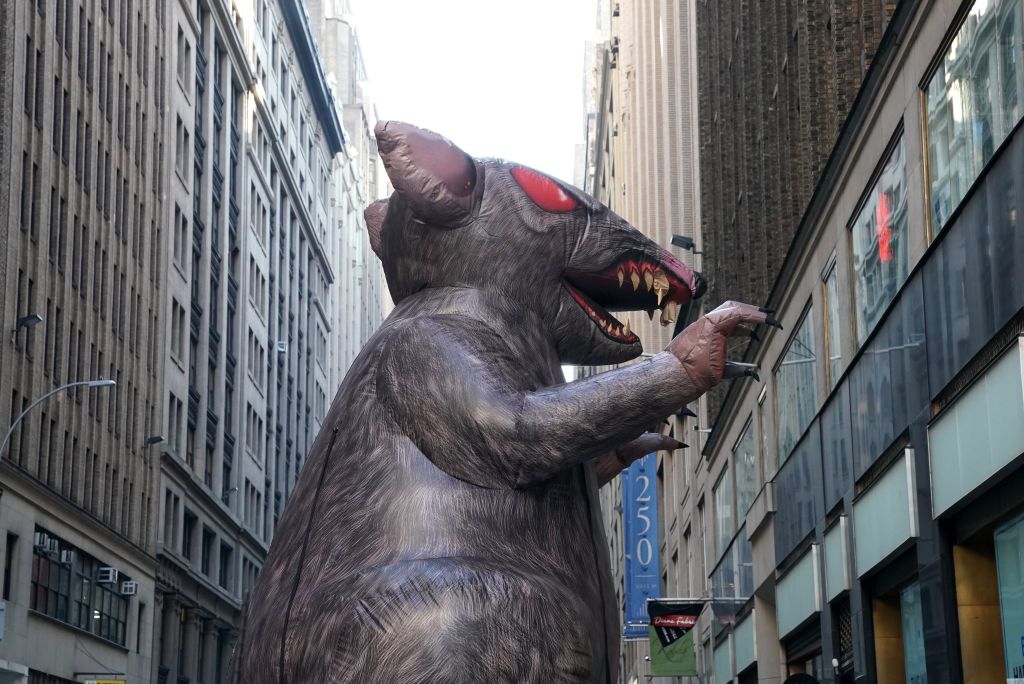
How Drug Cartels Took Over Social Media
April 26, 2025
“Most Workers Don’t Want Their Money Going to Foreign Wars”
April 26, 2025
Carnival celebrations in Germany’s Rhineland region are characterized by five things: Music, costumes, flowers, candy, and giant, handcrafted floats, many of which function as life-size political cartoons. On all fronts, this year’s festivities — concentrated in the cities of Cologne, Düsseldorf, and Mainz — did not disappoint.
One of the most eye-catching floats in February featured caricatures of Donald Trump and Vladimir Putin crushing Volodymyr Zelenskyy with the text “Hitler-Stalin Pakt 2.0” written on their arms: a reference to the Nazi-Soviet Pact of 1939, which paved the way for their partitioning of invaded Poland. Elsewhere, the US president was seen riding a carriage pulled by the Statue of Liberty, chained up and forced onto her knees.
Elon Musk — another prominent figure currently on German minds due to his support for the far-right Alternative für Deutschland (AfD) — was also featured. One float depicted him in a diaper bearing the party’s logo as well as a bicorne hat labeled “NAPO-ELON,” and another showed him and AfD leader, Alice Weidel, seated on a seesaw made of arms locked in perpetual Hitler salutes, Weidel raised high by Elon’s weight. Weidel also appeared in a float that turned her into the witch from “Hansel and Gretel,” handing swastika-shaped treats to unsuspecting children in shirts identifying them as “Erstwählers” or first-time voters.
While Carnival celebrations have long been used as a platform to ridicule powerful individuals, show solidarity with marginalized groups, and raise awareness for important issues like immigration and climate change, the holiday’s general atmosphere has become increasingly political in recent years, its brazen messaging reflecting the polarized state of German society and the Western world at large.
Some are pleased with this development. “I’ve never seen so many carnival orders addressing the topic of diversity,” Marc Bunse, of the Association of Rhenish-Bergisch-Märkisch Carnival Societies in Wuppertal, happily told public broadcasting service WDR, noting how the need to protect democracy from fascism proved to be one of this year’s overarching themes.
Others are less enthusiastic. The prominent display of swastikas and other Nazi imagery prompted heated debate about whether their satirical use violates Germany’s Criminal Code, which prohibits the public dissemination of slogans and gestures associated with the Third Reich. Popular float-builders like the Düsseldorf-based sculptor and illustrator Jacques Tilly received death threats and were reported to police on grounds of libel and hate speech — allegations which, though taken seriously by the authorities, are unlikely to lead to criminal investigations. Meanwhile, many have taken to social media to voice their displeasure, calling the floats “tasteless,” “unacceptable,” and “disgusting,” and proclaiming that “forbidden symbols do not belong at Carnival.”
But is any of this really about taste or taboos? Perhaps such remarks aren’t driven by concern for the Criminal Code and the dangerous ideological forces it was meant to contain, but rather by a desire to dismiss, suppress, even eliminate criticism of far-right parties like the AfD. This party has long maintained a delicate balance between courting neo-Nazis while also distancing itself from the legacy of the Third Reich in the eyes of the general public. Complaints about German Carnival having become “too political” — or, more precisely, too “woke” — overlook the festival’s radical history, which survived the Middle Ages, Napoleonic Wars, and World War II. But they also reveal a glaring contradiction at the heart of conservative movements in Germany and elsewhere: that these supposed champions of free speech absolutism are, in fact, highly selective when it comes to who should and shouldn’t be allowed to speak their mind.
Historians generally agree that the roots of German Carnival trace back to classical antiquity, when the cultural melting pot that was the Roman Empire combined a variety of regional and culturally specific festivals of revelry and role reversals. These included the pagan rituals of Germanic tribes that heralded the coming of springtime with food, drink, music, and dance, as well as Rome’s own, pre-Christian end-of-year celebration, Saturnalia. At this festival in honor of the god Saturnus, uptight republican virtuosity temporarily looked the other way to permit behaviors normally frowned upon, like gambling, and the rich sponsored lavish banquets for slaves and the working poor.
Just as early Christianity incorporated Roman and non-Roman rituals into its own emerging mythos, it also co-opted the traditions that would eventually evolve into Carnival. Because the aforementioned festivities preceded the period of fasting before Easter, they became an opportunity to “go all out” for one last time before indulgence gave way to sobriety and self-control. It is from this period that we get both the term “Carnival,” derived from the Latin carnis or “flesh,” and the German Fastnacht, or “night before fasting.”
The importance of role reversals continued throughout the Middle Ages, which saw the emergence of the “Büttenreden,” parodies and comedic speeches in which ordinary people made fun of their religious and secular leaders — the only time of year that they were allowed to do so without fear of repercussions. If this practice could exist during the tyranny of feudalism, it should come as little surprise that it also survived the political upheaval of the modern age. The blue, quasi-military uniforms of Cologne’s Carnival corps, for example, were first worn in the early nineteenth century to mock Napoleon Bonaparte, whose troops occupied the banks of the Rhine. When Cologne fell under Prussian rule following Napoleon’s defeat at Waterloo in 1815, the corps duly exchanged their faux-French uniforms for Prussian ones.
Carnival’s rebellious spirit even persisted when Adolf Hitler rose to power in Germany. Although celebrations from the period certainly produced their fair share of antisemitic floats — one from 1934, accompanied by people dressed as orthodox Jews, came with a banner that read, “The Last Ones Are Leaving” — they also witnessed numerous small acts of rebellion against Nazi propaganda.
In their 2010 book, Alaaf and Heil Hitler: Carnival in the Third Reich, historians Carl Dietmar and Marcus Leifeld point to posters depicting the Führer as a jester, Cologne Carnival speaker Karl Küppner raising his hand in a Hitler salute and joking, “Looks like rain,” and Leo Statz, the president of Düsseldorf’s Carnival committee, questioning whether Germany could win the war.
None of these acts went unpunished — the posters were destroyed, Küppner was imprisoned and barred from participating in future festivities, and Statz was executed for treason due to his comments. Yet, they demonstrate Carnival’s historic role as a platform for free speech and bulwark against authoritarian control.
The ruthless way in which the Nazis dealt with these rather tame transgressions should serve as a warning.
Although criminal complaints about Tilly’s floats are — as previously mentioned — unlikely to result in censorship or formal indictments, the fact that the artist has been reported to the police at all provides adequate cause for concern. Not only because the Criminal Code states — as both the Düsseldorf public prosecutor’s office and legal scholars like Goethe University chair of Criminal Law Matthias Jahn have already noted — that swastikas can be displayed for purposes of art and education, but also because the criticisms contained within his floats are justified, backed by repeated warnings from government watchdogs, journalists, and political scientists.
Discussions around the legality of certain Carnival floats also reveal the dangerous fallacies baked into the Criminal Code itself. Just as guilt over the Holocaust is continually cited to justify the German government enabling Israeli war crimes through the steady supply of weapons and the silencing of pro-Palestinian voices, efforts to restrict the use of Nazi symbolism even on clearly anti-fascist grounds have allowed parties like the AfD to fabricate an illusory distance between themselves and the Third Reich, facilitating their breakthrough into mainstream politics.
Conservative outrage about “overly political” Carnival floats highlights the limits of far-right free speech absolutism in Germany and beyond. Just as Weidel and other AfD leaders have either sued or attempted to sue people who publicly referred to them as Nazis, so, too, is Trump — despite his outspoken dislike of the Department of Justice — using the legal system to silence his own critics in the United States.
It is worth noting that politicians like Trump and Weidel — who have long operated outside the realm of truth and facts, and regularly pummel their opponents with false and baseless accusations — have been far more slanderous than those they have accused of slandering them.
At the same time, diving into the ins and outs of their legal troubles risks losing sight of the bigger, rather simple picture: that the transnational far right, for all its fearmongering about woke censorship, is not at all interested in protecting free speech. As a result, festivities like Carnival, which bring political criticism outside of the political sphere, are more important for the future of democracy than they have ever been before.
Great Job Tim Brinkhof & the Team @ Jacobin Source link for sharing this story.





